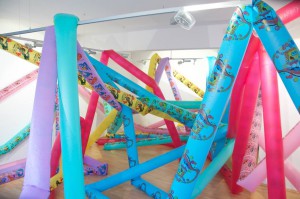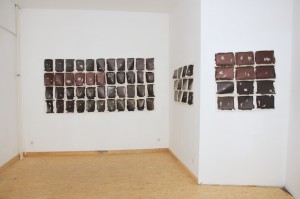Buy a Print here
D-Brane cosmology (with one attractor)
5. Juli 2016 von oscarledesma


5. Juli 2016 von oscarledesma

5. Juli 2016
von oscarledesma
Kommentare deaktiviert für D-Brane Cosmology
Buy a Print here
7. März 2015
von oscarledesma
Kommentare deaktiviert für D-Brane Cosmology. Installation und Performance
D-Brane cosmology (with one attactor) Installation von Oscar Ledesma. Ikosaeder Galerie 2015 (C)
28. Juni 2014 von oscarledesma

Mazunte
Installation aus der Reihe: Installationen für Niemanden.
Oscar Ledesma.
Mazunte. Aus Wikipedia:
Mazunte is famous for sea turtles. Before the mid 20th century, it had nearly no population, but that changed when a market for sea turtle meat and eggs developed. due to the many turtles that come to Mazunte to lay eggs, by the 1970s, Mazunte was the center of sea turtle hunting in Mexico, with its own slaughterhouse. Concern over the declining number of sea turtles eventually led to an absolute ban on turtle meat and eggs in Mexico, and deprived most families in Mazunte of their main source of income. To replace it, ecotourism based on the conservation of turtles and natural cosmetics developed. The main attractions of Mazunte today are the Mexican National Turtle Center and the Cosméticos Naturales de Mazunte.
Mazunte is a small beach town on the Pacific coast in Oaxaca, Mexico(15.66485°N 96.55388°W). Mazunte is located 22 km soutwest of San Pedro Pochutla on coastal Highway 200. Mazunte is located some 10 km to the west of Puerto Angel and just about 1 km from San Agustinillo and 264 km south of the capital of Oaxaca There are two etymologies for the name. Some sources state that “Mazunte” is derived from a Nahuatl phrase, “maxotetia” which means “please deposit eggs here. However, older residents of the community state that it is from the word “mizontle,” used by locals to refer to a crab species that used to be very abundant in the area.
Diese Galerie enthält 4 Bilder
17. März 2014 von oscarledesma

Many of my installations are made out of things I stumbled upon at random places. Sometimes I also use purely organic material. A year ago, I found a collection of reproduction prints of painting by several Old Masters, simply lying around in the street. It was very diverse: Flemish, Florentine, Venetian etc. They were printed on old paper and some of them were already mildewed. The bundle was surely something that somebody found in his basement and wanted to get rid of, something completely understandable, given that it is possible to find these paintings digitally, presented in high resolution on the Google Art Project.
Nevertheless, I took the collection with me to store them in my atelier. I somehow knew that I would someday use them for a new project. From time to time, I experimented a bit with them, I altered them using paint, scissors, tried to create collages out of them. During that process, I often thought of the person who threw away the prints. Maybe it was a young guy who found the collection in the basement of his new apartment. Or an old man bought them 50 years ago and then put them on the street, just like that.
Of course, it is legitimate to ask if these paintings still affect us in the days of Twitter, Facebook, and Instagram. Do they still speak to us, do we remember them? Today, 140 characters can mobilize millions of people. A video that lasts less than 10 seconds can initiate protests. Is there anything left within these paintings that can create a kind of meaning in such times? Their message seems to take too long to be transferred. Nowadays, people can lose patience when a website needs just five seconds longer to load. In a ‘classical’ painting, you cannot even comprehend the whole composition in five seconds.
Revisited Classics is an attempt to answer all these questions. Based on my developing thoughts, I started to paint over whole images with black paint. I left only a tiny spot free on every image. Thus, the information gets condensed into a minimal form, a very small fragment of the original.
But in this world of the Web 2.0, full of Social Media, memes and trolls, the only things that survive and become famous are plain and simply the anecdotal, the pornographic, the humorous, those things which the masses unconsciously choose. However, in the „world“ of the Installation, I am that which actively makes the selection. Small pieces of classical paintings for the present, an optimized view of the past that becomes the present. Almost a Classics 2.0.
Part of the series Installations for Nobody.
Aus der Reihe: Installation für Niemanden.
Oscar Ledesma 2013 ©
Diese Galerie enthält 10 Bilder
24. Januar 2014 von oscarledesma

Installation 1
Aus der Reihe: Installation für Niemanden.
Shop Galerie.
Oscar Ledesma 2014©
Diese Galerie enthält 9 Bilder
27. August 2012 von oscarledesma

Das Ende der Gewalt.
Perfomative Installation.
Bianca Wickinghoff | Oscar Ledesma
bei ruhrpuls festival. Bochum. 2011.
Diese Galerie enthält 9 Bilder
27. August 2012 von oscarledesma

Ich habe so viel gewient.
Installation. (Triptychon)
Bianca Wickinghoff | Oscar Ledesma
ruhrpuls festival. Bochum. 2011
Diese Galerie enthält 8 Bilder
27. August 2012 von oscarledesma

Der Garten der Lüste.
Installation. Bochum 2012
Bianca Wikinghoff und Oscar Ledesma
Ursprünglich ging es darum, das der Betrachter des Gartens der Lüste, das langsame Sterben der Schnecken beobachten sollte, die von dem Zucker, der mit Salz vermischt ist, in die Falle gelockt wurden. In einem ersten Versuch hatte Oscar eine Schnecke direkt auf das Pulver gesetzt: sie war nicht mehr in der Lage sich aus der Masse zu befreien und ist langsam regelrecht ausgelaufen. Sie ist zusehends geschrumpft, hat aber gekämpft und versucht sich aus der Masse zu befreien. Obwohl ich (als Gärtnerin) Schnecken zuvor noch gehasst habe, konnte ich mir das langsame Sterben nicht bis zum Schluss angucken und habe sie nach ca. 10 Min. wieder befreit, aber es war schon zu spät.
Oscar wollte es ursprünglich „Der Finger Gottes“ nennen und damit eine Parallele aufzeigen, das die Menschen in diese Welt hineingeboren werden und kaum eine Wahl haben, es gibt Spielregeln die wir nicht verstehen, Gefahren die wir nicht erkennen. Wir sind hilflos und orientierungslos wie diese Schnecken.
Natürlich halten wir uns für intelligenter und höher wertiger als eine Schnecke, aber sind wir das wirklich oder ist es nur eine Frage der Relation und des Standpunktes? Oscar hat das Gefühl, Gott behandelt die Menschen nicht viel besser als wir diese Schnecke.
Ich finde unser Experiment hat das Gegenteil bewiesen: während der Ausstellung lagen die Schnecken auf dem Holz und hatten die Wahl auf das Pulver zu kriechen oder nicht: sie haben es nicht getan und überlebt.
Der Titel ist eine homage an Hieronymus Bosch‘s Der Garten der Lüste, eines unserer gemeinsamen Lieblingsbilder.
Diese Galerie enthält 9 Bilder
1. Juli 2012 von oscarledesma

Die unerträgliche Leichtigkeit des Fisches.
Stoff, Weinreben, Wasser.
Bianca Wickinghoff und Oscar Ledesma ©
Installation Extraschicht 2012. Zeche Carl. Essen.
Diese Galerie enthält 10 Bilder